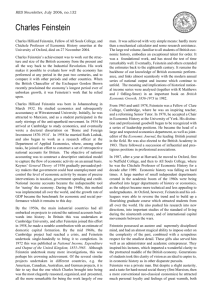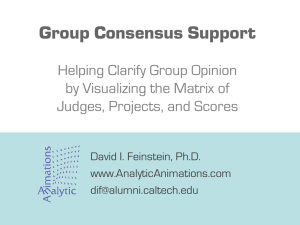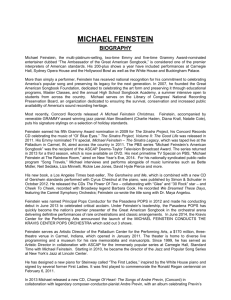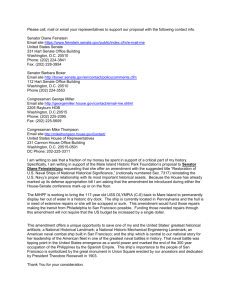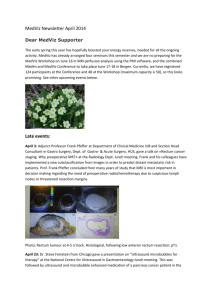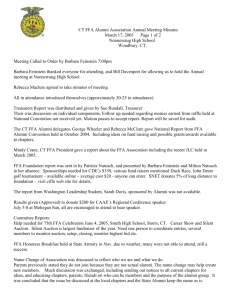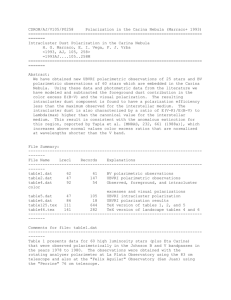Neuroscience and the classroom
advertisement
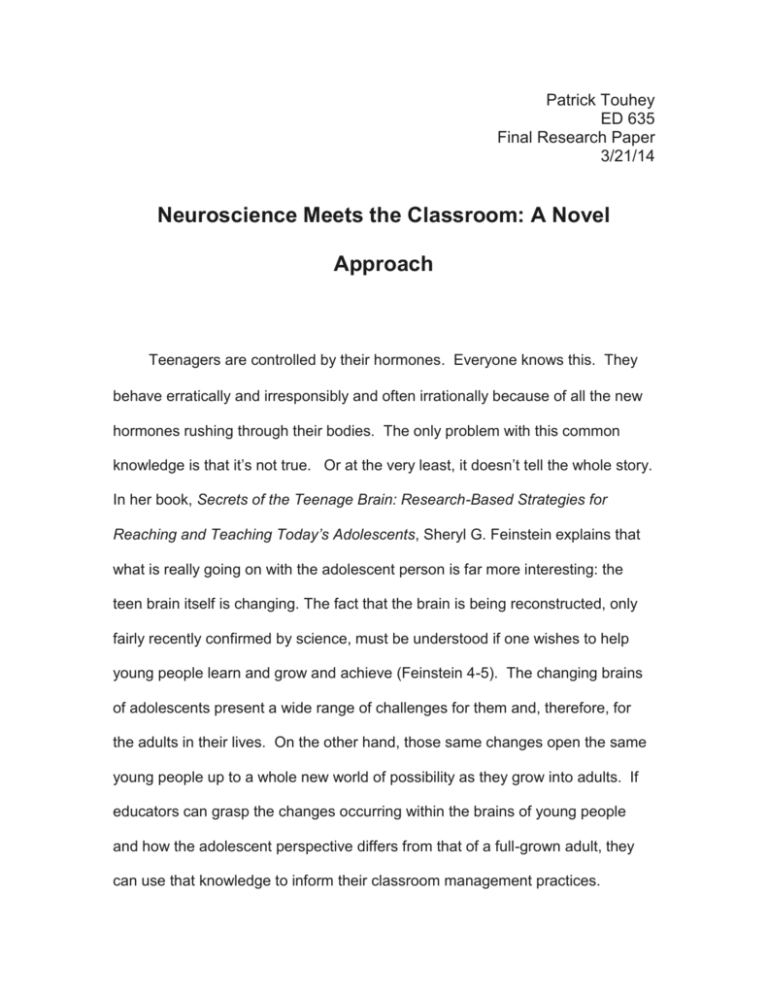
Patrick Touhey ED 635 Final Research Paper 3/21/14 Neuroscience Meets the Classroom: A Novel Approach Teenagers are controlled by their hormones. Everyone knows this. They behave erratically and irresponsibly and often irrationally because of all the new hormones rushing through their bodies. The only problem with this common knowledge is that it’s not true. Or at the very least, it doesn’t tell the whole story. In her book, Secrets of the Teenage Brain: Research-Based Strategies for Reaching and Teaching Today’s Adolescents, Sheryl G. Feinstein explains that what is really going on with the adolescent person is far more interesting: the teen brain itself is changing. The fact that the brain is being reconstructed, only fairly recently confirmed by science, must be understood if one wishes to help young people learn and grow and achieve (Feinstein 4-5). The changing brains of adolescents present a wide range of challenges for them and, therefore, for the adults in their lives. On the other hand, those same changes open the same young people up to a whole new world of possibility as they grow into adults. If educators can grasp the changes occurring within the brains of young people and how the adolescent perspective differs from that of a full-grown adult, they can use that knowledge to inform their classroom management practices. Teachers can use neuroscience to their advantage in engaging all students across the cultural, economic and ability spectrum - and, hopefully, helping them to achieve and become well-rounded adults. It is important to understand that teens are not being inexplicable for the sake of being inexplicable and they are not being unruly for the sake of being unruly. Adolescents “do not plot their unruliness; they are just trying to cope in a school run and designed by adults from and adult perspective - adults with brains that are structured and that function in ways vastly different from their own” (Feinstein 16). The teen brain is a work in progress, more a blueprint than a finished skyscraper. Teens are learning to “(navigate) a cerebral hurricane without a compass” (Feinstein 5). Studies done relatively recently revealed that “rather than leaving childhood with a brain ready to take on the responsibilities of young adulthood, teens have to contend with a brain that is destroying old neural connections and building new ones” (Feinstein 5). All these statements, raise an obvious question: what exactly are the changes happening in the brain of a young adult? Let us begin with a short explanation of basic brain functions. The brain is constituted of two main types of cells: glial cells, which bind everything together, and neurons, which are the communicators and the cells associated with learning. Neurons receive information via their dendrites and send information to other neurons via their axons. The space between neurons through which information passes is called a synapse. “Gray matter,” consisting of dendrites and synapses, is overproduced during adolescence and it opens teens to all kinds of new opportunities by allowing so many new connections to be made (Feinstein 11). However, synapses resemble muscles in that they are strengthened through use and weakened or lost through neglect - “use it or lose it” (Feinstein 9). Eventually, underused synapses will be pruned out of existence. After synapses are established, a process occurring countless times throughout the brain, glial cells produce the substance myelin, or “white matter,” to insulate the connections. The more insulated the connection, the faster the travel efficiency and the less likely that connection will be pruned (Feinstein 12). In essence, myelin builds the brain according to a blueprint constantly being reworked, part based on inherent processes and part on individual experiences. This kind of construction occurs throughout the young brain, but not all parts develop at the same time or rate because myelin is released to neurons in stages, meaning some aspects of human beings develop at different times (Feinstein 13). “The parietal lobes (which process and desegregate sensory information like sights, sounds, and smells), temporal lobes (which process visual information), cerebellum (which processes coordination and thinking skills), and hippocampus (seat of short-term memory) all benefit from the overproduction and pruning of synapses” during adolescence (Feinstein 13). One of the final areas to develop is also perhaps the most important in becoming an adult, the frontal cortex. The frontal lobes are responsible for “abstract thinking, language, and decision making” and keep the amygdala - the emotional center of the brain - in check. The importance of this development is difficult to overstate because it allows adolescents to “develop the ability to hypothesize, look into the future, deduct, analyze, and logically reason” (Feinstein 13). So how does this apply to teaching? Well, understanding this process is a good way to begin considering how best to approach young adults in the classroom. Well, if we wish to know what “software” - best practices - will work for students, it’s important to know what “hard drives” they are using (Feinstein 25). Also, teachers must realize the importance of the adolescent years in a child’s development. It is here that we find “a golden opportunity to build a better brain. It is also a golden opportunity to waste the brain’s potential and water it down instead” (Feinstein 11). Choices teachers make in the classroom can promote a student’s interest and foster new skills to last a lifetime or allow the same student to remain unmotivated and without new abilities. The stakes, therefore, are high. The first task of educators, the cornerstone of the classroom, is capturing the attention of students (Feinstein 18). With all of the sensory information bombarding them, it is difficult for the developing teenage brain to sort out what is most important and what is most dangerous. One thing it does understand is that it likes to maintain activities it finds pleasurable. Sheryl Feinstein explains: (T)he adolescent brain is fascinated by (and seeks out) novelty and emotion…Sitting through classroom instruction that fails to include either is the real test of a teen’s attention. Many teaching strategies and testing options have a great deal of difficulty keeping attention and arousing emotion. Worksheets require students to pay attention to something that evolution and instinct quite frankly say is irrelevant to life. Lecture, which can be an efficient way to deliver instruction, is often not emotionally charged. Objective tests, such as those in multiple-choice or true-false formats, rarely generate emotion and are extremely difficult to apply to real-world applications…We miss academic opportunities when we peruse strategies that neglect our emotional and cognitive constitution two powerful memory builders. (19) This process means that young people often filter out school as “boring” or “stupid” because they feel it does not apply to them. It is the teaching professional’s job to understand this and apply it to their classroom strategies by making things relatable and, hopefully, enjoyable. As an extended example, when trying to pique young learners’ interest in a subject like history, it might help to think outside the box. An educator might show them a trendy, though seemingly unrelated, commercial for Apple’s iPad Air. The commercial touches on all sorts of human endeavors, from love to poetry to science and engineering, and it displays a wide range of interesting human beings in the middle of activities, from a game of hockey to people exploring to quiet moments of reflection, and it does so in dramatic fashion with a narrator’s impassioned reading of a Whitman poem playing in the background. The commercial has a universal message about what makes us human the what the individual human being’s place in the great story of life. Helping students see that contributing a “verse” to the “powerful play” is really about participating in the subject of this class, history. Connecting the wide range of human interests, of which students must share at least a few, directly to what will be studying seems more exciting and novel when you put it that way than if you simply have them read from a textbook. Hopefully, this novel experience will connect with students emotionally and motivate them to take a personal interest in the subject and, therefore, put up with some of the more mundane parts of class. That example concerns a “big idea.” As Mariale Hardiman points out in her book, The Brain-Targeted Teaching Model for 21st-Century Schools: (W)hen we guide learning by providing students with broader view or “big picture,” we promote an understanding of the connections between prior knowledge and new learning and also demonstrate the relationships among learning goals. This is consistent with the brain’s propensity to look for patterns and associations between information at the forefront of thought and information stored in memory. (80) So finding a novel approach to engage students in the “big ideas” of your class can pay serious dividends, but novelty can take many forms. Educators should “(throw) novelty at teens from all sides - vary the pace and tone of your voice, dress in bell-bottoms, circulate around the room, use colored chalk, bring flowers into the room, or add the scent of lemon. Incorporate all the senses into the learning adventure” (Feinstein 20). Educators might also consider using novel formative assessments that are fun for teens while giving the teacher an idea of their development. Tailoring a game of Jeopardy to the current unit would be a good example. Another effective way to engage students, related to novelty, is by promoting creativity. According to Mariele Hardiman, “expanding instruction so that students are given the opportunity to think creatively by applying skills and content in meaningful, active, real-world problem-solving tasks…allows students to see how instructional goals relate to their own lives in real-world problem solving; this connection helps make the learning experience more meaningful and fun” (127). Much of students’ time in school is spent on convergent thinking, finding the “right” answer, but creativity is concerned with divergent thinking, finding many solutions to a problem, and repeated use builds and reinforces those synapses. Also, doing creative projects helps students master content, skills and concepts in because actively producing something with what they are taught leads to better consolidation of information within the long-term memory (Hardiman 119). Creative engagement helps students to become active participants in their education while gaining a valuable skill, thinking critically and solving problems creatively, for future success. Young learners, still developing their frontal lobes, are far more reliant on emotion, the processes controlled by the amygdala, than adults. “Despite observations to the contrary, teenagers are passionate beings,” as evidenced by their interest in friends, technology, sports and music (Feinstein 143). Knowing these passions exist, educators should incorporate technology (video, digital stories, the internet, etc), music (for example, listening to protest songs from the 1960’s and from the 2000’s and comparing them), group work (which promote various kinds of socializing) and games (which are generally fun and involve a competitive element) into their lessons. As Sheryl Feinstein explains: Relevance is the key to gaining student attention and prompting motivation. Relating content to real life is imperative for learning to occur. It’s difficult for students to find meaning and purpose from worksheets. (143) It’s important to keep things interesting for students or they, or their brain, may decide this class is not relevant to their lives. Learning through pleasurable experiences, ones that appeal to students’ natural interests, is a great way to engage students and make content “real” for them. Emotion is something of a double-edged sword when it comes to adolescents. While appeals to emotion can be effective in capturing the attention of young learners, their still-developing brains and bodies leave them more prone to outbursts of anger or bouts with depression (Feinstein 104). And though positive emotion can stimulate a teen’s ability to engage and learn, negative emotion causes stress which causes cortisol to be released into the body, shutting down interest and making it much more difficult for them to process and retain information (Hardiman 36-37). Teenagers face a wide range of stressinducers during their adolescent years, from sleep deprivation to issues at home to a greater self-awareness or problems with a significant other or even something as simple as an exam for your class (Feinstein 90-91). If teachers understand “the effects of stress on learning…they will be better able to avoid such stress-inducing practices” and help students meet their needs to become actively engaged learners (Hardiman 41). Keeping students engaged and sheltered from the many stresses in their life, or at least enough so that they can learn effectively, begins with establishing a positive emotional climate in the classroom (Hardiman 41). An educator’s classroom, in order to best serve the needs of the students, should be inclusive and give “children a sense of belonging and…group cohesiveness” (Hardiman 43). Helpful practices to promote such an environment include behavior-specific praise, praise for effort (rather than intelligence), creating predictable rituals or routines, acknowledging and redirecting emotional students, and taking the emotional temperature of the room are a few examples (Hardiman 42-45). But perhaps the best, most transcendent, practice a teacher should adopt also happens to be the simplest: caring. The nurturing of an adult can have a tremendous impact on a young learner, reducing cortisol levels and creating a feeling of connectedness to the school (Hardiman 46). And aside from helping with the learning process, students “who reported a feeling of connectedness through the presence of a caring adult in school were less likely to be involved in every risk behavior studied, including drug use, cigarette smoking, early sex, violence, and suicidal thoughts” (Hardiman 46). There are also some simple practices teachers can adopt in order to keep students focused, especially those with Attention-Deficit/Hyperactivity Disorder (ADHD) - a fairly common disorder among adolescents, and generally make their path an easier one to tread. Educators can do their best to reduce distractions. They can break down objectives and directions to simple, one step at a time instructions. Another good idea would be to introduce good organizational practices like keeping a binder with all necessary documents for class. It is also important for teachers to expect behavioral issues (which is not the same as accepting them) and remain calm in the face of explosive behavior and not engage in arguments with out of control students. (Feinstein 23) Neuroscience holds a great deal of promise for the world of secondary education. This paper has only barely scratched the surface of the potential to be found when we, as educators, look to the adolescent brain as a guide for our practices. With this knowledge comes responsibility. It is imperative that we consider these insights into the adolescent brain, especially those related to engagement and emotional health, when designing a classroom management plan. Because adolescence is such a pivotal, and sometimes volatile, time in a student’s life, the stakes are high. As Diane Feinstein puts it, “(e)ducators are not innocent bystanders merely witnessing this transformation of the teenage brain. We either promote neural growth or stunt it depending on the kind of classrooms we set up. Our job is to figure out how to create classrooms that will foster learning, support emotional and social growth in our students’ brains, and ease the transition from childhood to adulthood” (Feinstein 142). Works Cited Feinstein, Sheryl G. Secrets of the Teenage Brain: Research-Based Strategies for Reaching and Teaching Today’s Adolescents. New York: Skyhorse Publishing, 2013. Print. Hardiman, Mariale. The Brain-Targeted Teaching Model for 21st-Century Schools. Thousand Oaks: Corwin, 2012. Print.
